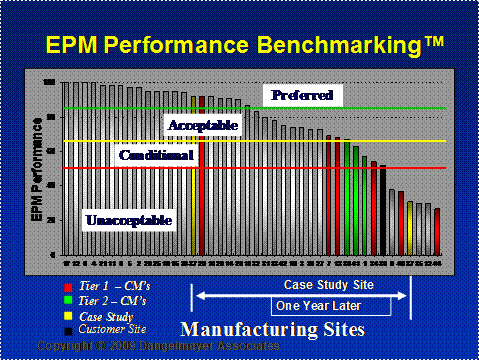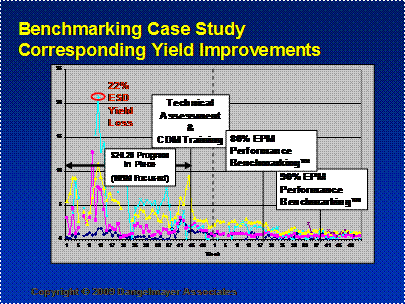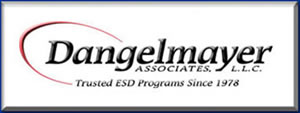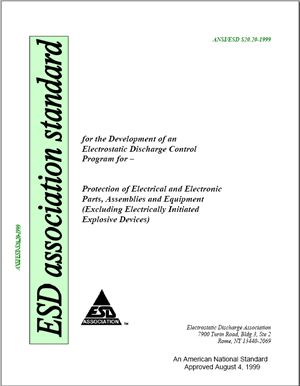Full Range of ESD & EOS Consulting Services: Training, Auditing, CDM, CBE, CDE, Class 0, Cleanrooms, S20.20 Programs
No Product Sales!
Our Services » ESD » Audits
Best Practices | Audits | Training | CBE | CLASS O | S20.20 | Documents | Testimonials
Dangelmayer Associates’ audits are conducted by Engineers with first hand manufacturing experience, advanced degrees and unparalled expertise! Our audits privde finding reports, photographs of findings, detailed recommendations, and the assignment of corrective action prioiries. Gaps will be identified between current best practices today’s technicologival challenges such as Class 000, CDM, CBE,
EOS and S20.20.
1) EPM Yield Risk Benchmarking™ Assessment:
Note: Applications include manufacturing & supply chain
“You do not need to do this: survival is not mandatory.”
- Dr. W. Edwards Deming

Notes:
1) May be used alone for benchmarking of individual or multiple sites or the supply chain
The EPM Performance & Benchmarking Assessments™ will be done over the phone. This may also be done independently without a technical assessment for benchmarking purposes of company locations and/or the customer’s supply chain. It is an accurate tool for quantifying the quality of an ESD Program and for qualifying suppliers. For instance, a site may end up with a score of 37% and be in the high risk zone or 97% and be in the preferred zone.
The questions are designed to analyze the ESD quality system. This is because the quality system ultimately governs the outcome of a manufacturing process. Questions are asked such as “Has management formally appointed an ESD Program Manager?” and “Are current best practices such as CDM, CBE and Class 0 adequately addressed in the governing ESD requirements document?”.
Extensive data confirms that the Performance Benchmarking Score™ correlates to manufacturing yield improvements (see example below).
Upon completion, this highly effective tool becomes a road map for improvement or development of a sound ESD Program. The metrics generated by this process provide management with capability to measure and track the ESD program performance of individual sites as well as the corporation’s relative position within the industry. The survey results are discussed in the Executive Summary of Annual Technical Assessment and are summarized in a PowerPoint presentation.

2) Advanced Technical Assessment/Audit:
Note: Conducted by Engineers with first hand manufacturing experience, advanced degrees and unparalleled expertise!
“Wow – this is really an excellent assessment and report! I was just thinking how our other consultants haven’t really dealt with the quality system, so I appreciate you giving us a whole “turn-key solution”.
- Bob Herrick, PhD – Finisar, Senior Reliability Engineer
This advanced technical assessment/audit, in concert with our EPM Performance Benchmarking™, Assessment provides the most comprehensive roadmap for improvement available today. Our assessments/audits provide findings reports, photographs of findings, detailed customized recommendations, and the assignment of corrective action priorities. Gaps will be identified to current best practices as well as to the Customer's choice of standard, such as Internal Requirements, S20.20 or EIA-625.
Technical Assessment Benefits:
- Provides detailed information that can be used for either improving programs or resolving ESD problems.
- Identifies problems and provides solutions to the root cause of existing failure mechanisms.
- Qualifies manufacturing facilities for present and future product requirements.
- Contributes to increased yields, process control, profitability, and customer satisfaction.
Technical Assessment/audit Highlights:
- This is our most comprehensive assessment/audit and is intended for the quality conscious company that is serious about not only solving ESD problems but also about preventing recurrence.
- A two day thorough sampling evaluation of the ESD process characteristics, ESD handling procedures/protocols, and state-of-the-art electrical and ESD event detection measurements of the ESD facilities automation, and test equipment.
- Emphasis will be placed on the analysis of automation/test equipment and charged device model mitigation techniques.
- Internal auditors will be invited to observe during the assessment and will be shown how to perform the assessments.
- Gaps will be identified to current best practices as well as to the standard of customer choice, such as Customer Requirements, S20.20 or EIA-625.
- Comprehensive documentation (approximately 50 pages) of specific findings and recommendations will be included along with photographs of findings and priorities for corrective actions.
- Technical explanations of findings will be shared during the assessment to facilitate customer understanding of the issues and any corrective actions that may be necessary.
State-of-the-art Test Equipment:
- Three varieties of ESD Event Detection Equipment
- Comprehensive set of ESDA ANSI Compliant test equipment
Root Cause Analysis
Note: Conducted by our most experienced Engineers and Scientists with advanced degrees and/or specialized expertise including product ESD designed-in protection.
We are uniquely equipped to efficiently locate the root cause of ESD damage in complex manufacturing operations due to our team of advanced engineering experts and over 200 years experience. We pioneered many aspects of ESD event detection techniques and have unequalled experience with these and other advanced auditing techniques, Thus, it is possible to readily analyze sophisticated automated or manual production lines and pinpoint the root cause of ESD failure.
Once the root cause has been identified we can draw on our depth of experience and technical understanding of the physics of ESD to efficiently resolve manufacturing issues or to redesign products to enhance designed-in protection.
3) S20.20 Pre-Assessment Audit:
Note: Conducted by Engineers who have managed ESD manufacturing programs that were S20.20 Certified under their leadership.
"I’ve audited literally hundreds of ESD programs and, without a doubt; this program is the best I have ever seen. It's a world class benchmark…”
- Bill Gifford, DNV ISO 9000 Registrar, S20-20 Lead Auditor.
This S20.20 Pre-Assessment Audit may be done solely for the identification of gaps to S20.20 and expert recommendations for achieving S20.20 certification on the first try. It may also be combined with our Advanced Technical Assessment as described above for a complete assessment of gaps to both S20.20 and current best practices.
A complete analysis will be conducted of the Administrative and Technical Elements of S20.20 such as the ESD Control Program Plan. Gaps to S20.20 will be succinctly identified along with customized expert recommendations for corrective actions.
S20.20 - 2007 Administrative Requirements:
- ESD Control Program Plan
- Training Plan
- Compliance Verification Plan
S20.20 - 2007 Technical Requirements:
Technical Requirement |
Implementing Process |
Test Method |
Required Limit(s) |
Grounding / Bonding System |
Equipment Grounding Conductor |
ANSI/ESD S6.1 |
< 1.0 ohm impedance |
Auxiliary Ground |
ANSI/ESD S6.1 |
< 25 ohms to the Equipment Grounding |
|
Equipotential Bonding |
ANSI/ESD S6.1 |
< 1.0 x 109 ohms |
Personnel Grounding Technical Requirement |
Product Qualification1 |
Compliance Verification |
||
Test Method |
Required Limit(s) |
Test Method |
Required Limit(s) |
|
Wrist Strap System2 |
ANSI/ESD S1.1 (Section 5.11) |
< 3.5 x 107 ohms |
ESD TR53 |
< 3.5 x 107 ohms |
Flooring / Footwear System – Method 1 |
ANSI/ESD STM97.1 |
< 3.5 x 107 ohms |
ESD TR53 |
< 3.5 x 107 ohms |
ESD TR53 |
< 3.5 x 107 ohms |
|||
Flooring / Footwear System – Method 2 |
ANSI/ESD STM97.1 |
< 109 ohms |
ESD TR53 Flooring Section |
< 1.0 x 109 ohms |
ANSI/ESD STM97.2 |
< 100 volts |
ESD TR53 Footwear Section |
< 1.0 x 109 ohms |
|
Technical Requirement |
ESD Control Item |
Product Qualification1 |
Compliance Verification |
||||||
Test Method |
Required Limit(s)2 |
Test Method |
Required Limit(s) |
||||||
EPA |
Worksurface |
ANSI/ESD S 4.1 |
< 1 x 109 ohms |
ESD TR53 |
< 1 x 109 ohms resistance to ground |
||||
Wrist Strap Cord |
ANSI/ESD S1.1 |
0.8 x 106 to |
For compliance verification of a wrist strap system, see Table 2. |
||||||
Wrist Strap Cuff |
ANSI/ESD S1.1 |
Interior |
|||||||
Exterior |
|||||||||
Wrist Strap Cord Bending Life |
ANSI/ESD S1.1 |
> 16,000 cycles |
|||||||
Footwear |
ANSI/ESD STM9.1 |
< 1 x 109 ohms |
See Table 2 |
See Table 2 |
|||||
Foot Grounders |
ESD SP9.2 |
< 1 x 109 ohms |
See Table 2 |
See Table 2 |
|||||
Flooring |
ANSI/ESD S7.1 |
< 1 x 109 ohms |
See Table 2 |
See Table 2 |
|||||
Seating |
ANSI/ESD |
< 1 x 109 ohms |
ESD TR53 |
< 1 x 109 ohms resistance to ground |
|||||
EPA |
Ionization other than Room Systems |
ANSI/ESD STM 3.1 |
User defined |
ESD TR533 |
User defined |
||||
Ionization (Room Systems) |
ANSI/ESD STM3.1 |
User defined |
ESD TR533 |
User defined |
|||||
Shelving |
ANSI/ESD S4.1 |
< 1 x 109 ohms |
ESD TR53 |
< 1 x 109 ohms resistance to ground |
|||||
Mobile Equipment |
ANSI/ESD S4.1 |
< 1 x 109 ohms |
ESD TR53 |
< 1 x 109 ohms resistance to ground |
|||||
Continuous Monitors |
User defined |
User defined |
ESD TR53 |
Manufacturer defined |
|||||
Garments |
Static Control Garment |
< 1 x 1011 ohms |
ESD TR53 |
< 1 x 1011 ohms |
|||||
Groundable Static Control Garment |
< 1 x 109 ohms |
ESD TR53 |
< 1 x 109 ohms |
||||||
Groundable Static Control Garment |
< 3.5 x 107 ohms |
ESD TR53 |
< 3.5 x 107 ohms |
||||||





